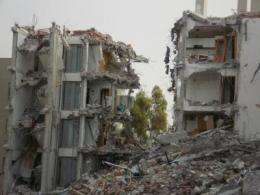A new method accounts for social factors when assessing the seismic risk of a city

Seismic risk not only depends on the magnitude of the tremor itself but also on the resistance of buildings and the social characteristics of its population. A team of Spanish scientists have presented a new method for calculating seismic risk incorporating aspects like social fragility and the chances of collective recovery.
"When faced with the possibility of an earthquake, up until now the physical risk of the city has only ever been evaluated. This, in other words, means damage to buildings and infrastructures taking into consideration the amount of people inside," as explained to SINC by Liliana Carreño, researcher at the Polytechnic University of Catalonia (UPC). Her team proposes a new method of carrying out an overall assessment of the seismic risk of an urban area, taking into account the social strengths and weakness and the city's governance.
The system created by Carreño and her team considers values such as "crime rates, whether there are marginalised areas, the number of hospital beds, training of hospital staff, etc, which all constitute factors of fragility and social capacity," explain the researchers. "This methodology greatly improves on our ability to assess future losses because it takes into account the social condition of the exposed population, which was previously treated as a mere number," states Carreño.
Published in the Bulletin of Earthquake Engineering, the new approach has another added value: it uses a technique based on 'fuzzy logic theory' which allows for the use of qualitative information obtained from expert opinion when the necessary numerical information is lacking.
Translating Opinions to Numbers
"The methods for making a complete risk calculation in a given urban area require great quantities of information that is not always available" highlights the researcher. According to Carreño, seismic risk specialists have always faced complex problems concerning imprecise information. "We can now translate linguistic variables like a lot, a few, slight, severe, scarce and enough into mathematic formalism for their subsequent measurement," outlines the scientist.
In order to verify the method's validity, Carreño and her team applied it to the cities of Barcelona and Bogotá (Colombia). She adds that "the Catalan city is a good model since its seismic risk has been subject to study for more than 20 year." Its results confirmed expected risk levels: medium-high for Bogotá and medium-low for Barcelona.
As Carreño concludes, "Barcelona's assessment was carried out with the availability of sound information. But, the most important aspect of this model is that it is especially useful when studying an urban space that does not have such an advantage and where information is lacking."
More information: Bull Earthquake Eng 10:547-565. 2012. DOI 10.1007/s10518-011-9302-2
Journal information: Bulletin of Earthquake Engineering



















